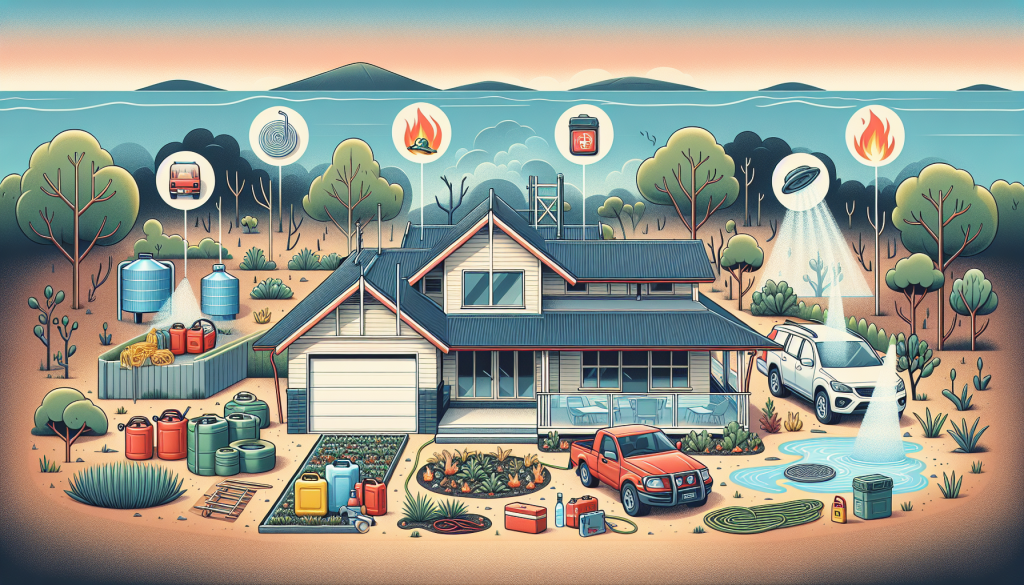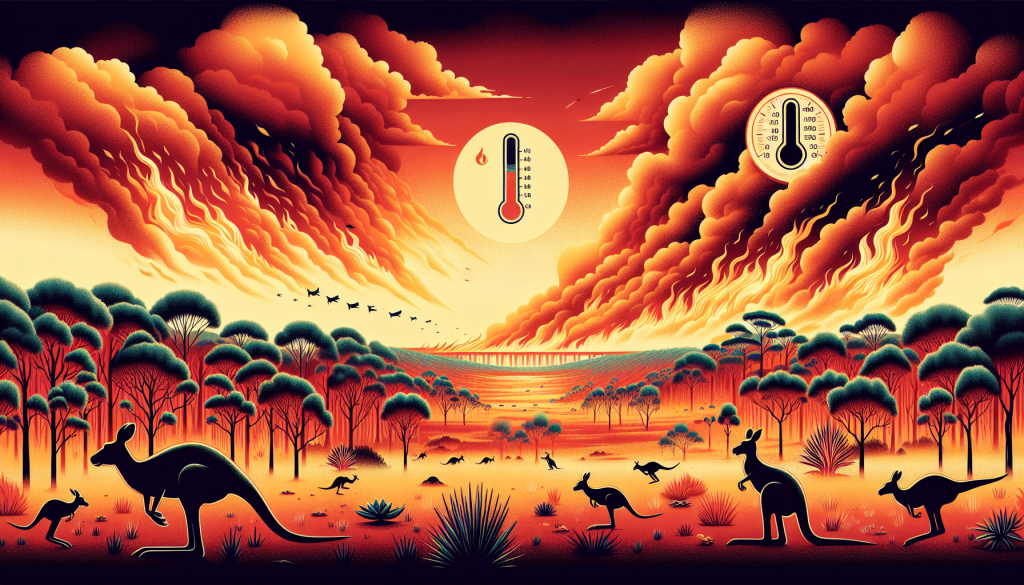Now Reading: Bushfire Smoke and Public Health: What You Need to Know
-
01
Bushfire Smoke and Public Health: What You Need to Know
Bushfire Smoke and Public Health: What You Need to Know

As the golden hue of the sun gets frequently replaced by the deep orange of bushfire smoke, Australians know all too well the sight and scent that accompanies this natural phenomenon. Bushfires, while a natural part of Australia’s ecosystem, have increasingly become a topic of concern due to their impact on public health. Not only do they destroy vast stretches of the iconic Australian bush, but the smoke they produce has raised several health questions. This review delves into the intricacies of bushfire smoke and its implications on public health, shedding light on preventive measures and the silver lining amidst the haze.
The Composition of Bushfire Smoke
Particulates and Their Role
Bushfire smoke, a frequent companion during the Australian bushfire season, is more than just a haze that envelops the sky. On closer examination, this smoke reveals itself as a medley of minute particles and gases. Dominating this mix is the fine particulate matter, commonly known as PM2.5. With a diameter less than 2.5 micrometres, these particles are so tiny that they can easily infiltrate the human respiratory system. When inhaled, they not only pose respiratory risks but also carry with them other hazardous substances, thereby amplifying their potential health impacts. Given the prominence of bushfire smoke during the Australian fire season, understanding the depth of these particulates becomes crucial for the public.
Gases, Chemicals, and Origin Points
Beyond particulates, bushfire smoke also harbours an array of gases and chemicals. Carbon monoxide, a colourless and odourless gas, stands out in this mix, potentially disrupting the blood’s capacity to carry oxygen when inhaled in large quantities. Alongside, volatile organic compounds (VOCs) add to the complexity, contributing to the characteristic smell of the smoke and potentially impacting health. The composition of this smoke also varies based on what’s burning. For instance, burning eucalyptus releases different chemicals compared to pine or grass. It’s a dynamic concoction, ever-changing with the fuel source.
Quick Facts:
- PM2.5 particles can infiltrate the human respiratory system.
- Carbon monoxide disrupts the blood’s oxygen-carrying capacity.
- The composition of smoke changes based on the burning material.
The Impact on Respiratory Health
Immediate Effects of Bushfire Smoke Inhalation
Bushfire smoke, with its intricate cocktail of particles and chemicals, can take a toll on one’s respiratory system immediately upon exposure. The most common symptoms include coughing, wheezing, shortness of breath, and a sore throat. These manifestations are primarily due to the fine particulate matter, PM2.5, which, when inhaled, can penetrate deep into the lungs, causing inflammation. Such immediate effects are especially pronounced during the peak of the Australian bushfire season, when vast swathes of land are engulfed in flames, releasing massive volumes of smoke into the atmosphere. Beyond the lungs, the eyes can also bear the brunt of this smoke, with many reporting symptoms like redness, itching, and a stinging sensation. It’s worth noting that these immediate effects can be particularly severe for certain vulnerable groups, such as children, elderly individuals, and those with pre-existing respiratory conditions.
Long-Term Impacts and Vulnerable Groups
While the immediate effects of bushfire smoke inhalation can be distressing, the long-term implications warrant equal attention. Prolonged exposure, especially during recurring Australian fire seasons, can lead to chronic respiratory conditions. There’s growing evidence suggesting that individuals exposed repeatedly to bushfire smoke may face an increased risk of developing conditions such as chronic obstructive pulmonary disease (COPD), asthma, and even lung cancer in extreme cases.
- Children, due to their developing respiratory systems and higher breathing rates, are particularly at risk.
- Elderly individuals often have weakened immune systems, making them more susceptible to the harmful effects of bushfire smoke.
- Those with pre-existing health conditions, such as heart or lung diseases, face heightened risks during the Australian fire season.
Given the severe implications on respiratory health, it’s vital for everyone, especially those in vulnerable groups, to take proactive measures during the bushfire season. This not only ensures their immediate safety but also safeguards their long-term health.
Preventive Measures and the Silver Lining
Strategies to Protect Against Bushfire Smoke
Amid the Australian bushfire season, which has grown notably intense in recent years, safeguarding oneself from the harmful effects of bushfire smoke is of paramount importance. One of the most effective strategies involves creating a ‘clean space’ in the home. This area, ideally a room with few windows and doors, can be equipped with a portable air cleaner to significantly reduce particulate levels. Furthermore, ensuring that your home’s air conditioning system is set to ‘recirculate’ can prevent outdoor smoke from seeping in. For those who need to venture outside during smoky conditions, wearing a mask, particularly those rated P2 or N95, can offer some protection. Of course, while masks can filter out harmful particles, they cannot protect against toxic gases, emphasizing the importance of limiting outdoor activities during peak smoke events.
It’s also advisable to keep windows and doors shut, especially during periods when smoke is heavy. Utilizing weather stripping or towel barriers can further seal gaps and prevent smoke infiltration. On top of these preventive measures, staying hydrated, avoiding strenuous outdoor activities, and keeping medications on hand for those with pre-existing conditions can prove beneficial.
The Positive Turn of Events
The hazards of bushfire smoke, while evident, have spurred a series of commendable actions. With the recurring Australian fire season, public health officials, communities, and even tech innovators are joining hands to curtail the adverse effects. Mobile apps and websites have sprung up, providing real-time air quality data and bushfire updates. These digital tools have become invaluable for Australians, allowing them to make informed decisions about outdoor activities. Moreover, community workshops focusing on bushfire preparedness have seen a surge, arming individuals with knowledge and tools to face the challenges head-on.
On the brighter side, the increased attention on the issue has led to significant investments in research. Innovative solutions, from smoke-filtering technologies to advanced firefighting strategies, are now in the limelight. Collaborations between scientists, firefighters, and policymakers are ushering in a new era where the Australian spirit, backed by science and community resilience, stands tall against the smoke-filled challenges.
- Creating a ‘clean space’ at home to combat bushfire smoke.
- Utilizing real-time air quality apps to make informed decisions.
- The rise of community workshops and research investments in light of the bushfire threat.
A Breath of Fresh Knowledge
Stepping Up the Public Awareness Game
One of the notable successes in the wake of the Australian fire season is the heightened public awareness about the implications of bushfire smoke on health. With increased media coverage, community outreach programs, and educational campaigns, Australians have become more knowledgeable and proactive about safeguarding their health. These initiatives have not only provided information on the harmful effects of bushfire smoke but have also offered tangible solutions on how to mitigate risks. These include:
- Utilizing masks designed to filter out PM2.5 particles.
- Understanding the importance of creating “clean air spaces” at home.
- Staying updated on local air quality reports to determine the best times to venture outside.
This table summarizes the key information from the provided sources regarding the health impacts and the composition of bushfire smoke during the 2019-2020 bushfires in Australia.
Source | Year | Topic | Key Information |
2019-2020 | Health Impacts | Bushfire smoke associated with various health conditions including loss of life, smoke pollution, impacts on water supplies, and destruction of infrastructure | |
2019-2020 | Health Advice | Public advised to stay indoors due to smoke blanketing parts of Australia | |
2019-2020 | Health Effects Summary | Guidance summarizing known health effects of bushfire smoke exposure | |
2019-2020 | Smoke Composition & Toxicological Assessment | Mention of a publication on bushfire smoke plume composition and toxicological assessment | |
2019-2020 | Environmental & Health Impacts | Disastrous wildfire season highlighting environmental and health impacts of climate change due to bushfire smoke exposure |
Empowering Communities During the Australian Bushfire Season
The very spirit of Australia thrives on community. When faced with challenges, be it sports or the harrowing bushfire season, Australians band together. The Australian bushfire season has, in fact, witnessed local communities becoming more empowered and proactive. Schools, businesses, and local government units have started incorporating bushfire smoke preparedness into their annual planning. Workshops on creating safe spaces during peak bushfire smoke days, distributing masks, and running community health checks have become common. Such commendable initiatives not only protect individuals but also strengthen the community fabric, ensuring that when the smoke rises, the Australian spirit stands taller.
Footnote and Disclaimer
Understanding the Nature of Bushfire Smoke
It’s essential to recognise that while every effort has been made to provide accurate and up-to-date information in this article, bushfire smoke and its associated health impacts are areas of ongoing research. As the Australian bushfire season continues to evolve in intensity and frequency, the associated risks and preventive measures might also see shifts. The vastness and complexity of the Australian fire season make it an ever-evolving topic of study. Hence, while we ensure that our content is rooted in current findings and expert opinions, we also acknowledge that the nature of bushfire smoke, its components, and its health implications are not entirely static.
Reliability and Reference Limitations
- This article primarily sources information from established public health organisations and research studies focused on “bushfire smoke” and its effects.
- While the aim is to provide readers with a comprehensive overview of the topic, we admit that the article might not cover every nuance or recent development, especially as the “Australian bushfire season” unfolds.
- It’s always advisable to consult health professionals and local authorities for personal advice during periods of heavy smoke exposure or when experiencing related health symptoms.
Readers are encouraged to approach this review as a foundation for understanding the broader picture, rather than an exhaustive source. For the most recent and personalised information, turning to official health departments and local government advisories during the Australian fire season would be the most prudent course of action.





























